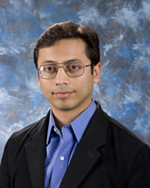EECS Professor Honored With Office of Naval Research Young Investigator Award
Syed Jafar will receive $300,000 over three years for communication network research
 Syed A. Jafar, Ph.D., assistant professor of electrical engineering and computer science, was named one of 27 recipients of the 2008 Office of Naval Research’s (ONR) Young Investigator Awards. The Young Investigator Program (YIP) seeks to attract outstanding new university faculty members to naval research by supporting and encouraging their research careers.
Syed A. Jafar, Ph.D., assistant professor of electrical engineering and computer science, was named one of 27 recipients of the 2008 Office of Naval Research’s (ONR) Young Investigator Awards. The Young Investigator Program (YIP) seeks to attract outstanding new university faculty members to naval research by supporting and encouraging their research careers. The awards recognize research achievements, the potential for continued outstanding research efforts, and strong support and commitment from honorees’ home research institutions. Recipients receive up to $100,000 a year for a period of three years, with additional funding for equipment or collaborative research with a Navy lab.
Jafar was honored for his research proposal, “Interference Alignment and the Promise of Unlimited Secure Spectrum Access for Tactical Communication Networks” within the Command Control Communications, Computers, Intelligence, Surveillance and Reconnaissance category. This year's YIP awardees were also named in four other naval priority research areas: Ocean Battlespace Sensing; Sea Warfare and Weapons; Warfighter Performance; and, Naval Air Warfare and Weapons.
The capacity of wireless networks - the data rates these networks can reliably carry - is one of the most important research areas of information theory. Interference, which is caused by simultaneous transmissions from multiple wireless transmitters, has an adverse impact on the efficiency and capacity of wireless networks. The traditional approach to avoiding interference over wireless networks is to divide the available spectrum/channel/bandwidth among the users proportionally. For example, if there are 10 wireless users who wish to access the same channel, then each user is allotted 10 percent of the available spectrum.
However, Jafar’s group has found a new approach called interference alignment – designing signals so that they cast overlapping shadows at the unintended receivers while they remain distinguishable at the intended receiver – that can, in theory, allow every user to access half the spectrum, even when there are more than two users competing for the same channel. Potentially, this means the data rates of wireless networks can be significantly improved and wireless networks are not fundamentally interference-limited as was previously believed.
The proposed research for the ONR Young Investigator Program builds upon this work. In Jafar’s projected research, his team will explore the potential for unlimited spectrum availability, in which an unlimited number of users can access the same spectrum without interference, as well as the security and robustness (or resistance to jamming) of interference alignment for tactical communication networks like those used by the Navy.
Jafar received his B. Tech. degree in electrical engineering from the Indian Institute of Technology (IIT), Delhi, India, in 1997, an M.S. degree in electrical engineering from the California Institute of Technology (Caltech), in 1999, and a Ph.D. degree in electrical engineering from Stanford University in 2003. His industry experience includes positions at Lucent Bell Labs, Qualcomm, Inc., and Hughes Software Systems. His current research interests include multiuser information theory and wireless communications.
Jafar received the National Science Foundation Faculty Early Career Development (CAREER) Award and the UC Irvine Engineering Faculty of the Year award in 2006. He is a co-recipient of the DARPA ITMANET Young Investigator Team award. Jafar serves as associate editor for the Institute of Electrical and Electronics Engineering (IEEE) Transactions on Communications and Communications Letters.
